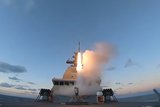Ensuring Information Superiority in Modern Military Operations (Studio)
Photo: Intelsat
Brought to you in partnership with Intelsat
Information superiority is not a new concept. However, what is new in today’s complex and multi-domain theatres of operations is the quantity of information necessary to gain and retain information superiority and the speed at which it needs to travel to the tactical edge.
As David Broadbent, President of Government Solutions for Intelsat, explains: ‘The team that gets to the right answer first wins these days. And what we mean by the right answer is a function of the ability to collect the data, process it and get those insights to the right person at the pointy end of the spear.’
Broadbent adds, ‘The sensitive data can come from a variety of sources and may need to be processed at different locations, sometimes near the tactical edge or even continents away. The key is to get the processed insights to the right people as quickly as possible to drive the speed of response.’
Communications is a critical component of that process, and for Intelsat, this means working on future SATCOM technologies.
Building on decades of experience supplying secure and resilient SATCOM services to armed forces worldwide, the company will soon leverage critical technologies, such as software-defined satellites and optical links, to ensure speed, resilience, security and, ultimately, information superiority at the tactical edge.
Technical Challenges of Modern Warfare
The complexity of modern warfare demands complete situational awareness across cyber, land, air, and sea domains.
Initiatives like the US Joint All Domain Command and Control (JADC2) exemplify the need to gather data from multiple sensors and redistribute processed information swiftly across different platforms.
This raises a critical challenge: transferring sensitive data quickly and securely to the tactical edge.
‘The primary concept, from a modern warfare perspective, is the ability to utilise all available assets across all available domains in an integrated and coordinated approach that delivers an optimal capability to the tactical edge,’ Broadbent explains.
Enabling Fast and Secure Multi-Domain Communications
One of the critical advances in SATCOMS over the past decade has been orbital expansion. With the development of Low Earth Orbit (LEO) and Medium Earth Orbit (MEO) orbits to complement Geostationary Earth Orbit (GEO), armed forces can now expand their communications networks – and, as it happens, also switch between them for improved coverage and security. But this has come at the cost of additional terminals and terrestrial infrastructure.

Cognisant of the importance of ensuring a seamless transition between orbits, as well as from ground to space and back, Intelsat has addressed three key components to facilitate interoperability and data sharing, and to simplify deployment.
First, by partnering with LEO operators and providing multi-orbit terminals, Intelsat provides dynamic capacity coverage across GEO and LEO orbits wherever needed.
Second, because information needs to also travel seamlessly between space and ground, Intelsat has integrated its satellite coverage with the terrestrial network.
This enables true hybrid satellite and fibre connectivity with access to multiple platforms and telephones. These first two components facilitate quick and efficient data sharing, allowing complete interoperability.
The third component, delivering this service through efficient Smart Edge devices, optimises both the network capability and the users’ ability to quickly deploy and utilise that data into actionable decisions faster than the opposite adversary.
Broadbent elaborates, ‘Our multi-orbit network integrates Geo and LEO satellite capacity using a software-defined approach that’s inherently flexible. This helps facilitate seamless data exchange and real-time collaboration across various orbital bandwidths and user solutions.’
As Rory Welch, Vice President for Global Government Satellite Services at Intelsat, explains: ‘Security is only as strong as the weakest link, and this can be any part of the security ecosystem, such as satellites, teleports in the ground network, communications, or traffic.’
That is why Intelsat has built capabilities into its satellites to mitigate threats such as RF interference and jamming, as well as the ability to geo-locate the source of interference. Intelsat satellites also feature built-in encryption.
Building the SATCOM of the Future
The ability to communicate across domains – cyber, sea, air, land – will soon become the norm rather than the exception. This is evident through several worldwide programmes privileging multi-platform, multi-domain solutions.
‘This trend will drive the need to enable all of the military nodes for multi-orbit multi-band communications to create a mesh network that is resilient, self-healing, and allows data to be sensed and then transported and processed across this mesh network,’ Broadbent explains.
‘And, of course, this will have to happen on orbit and across terrestrial networks,’ he adds.
Intelsat has been developing standardised waveforms to enable a seamless shift toward the future of multi-domain communications to make military and commercial waveforms compatible.
This allows armed forces to benefit from the military waveforms to share sensitive data that can be transferred across platforms through commercial assets and infrastructure - thus benefitting from the speed of commercial capability and investment.
Additionally, Intelsat is also creating new industrial partnerships to invest in new capabilities to continue enabling the future mesh network’s increased speed and security needs.
This implies moving beyond RF and venturing into the optical link space. Optical links will provide a new layer of connectivity that will create greater speeds and data throughputs between orbits and between ground and space.
Broadbent comments, ‘From an optical communications perspective, we’re investing significantly with technology partners to develop our ecosystem. Optical links are a game-changer in terms of speed, data volume, and security, enabling the creation of a global mesh network that is highly resilient and secure.’
To learn more about Intelsat's solutions, see the company at Eurosatory Hall 5b- E453
More from Studio
-
![Precision on Demand: The New Age of Loitering Weapons (Podcast)]()
Precision on Demand: The New Age of Loitering Weapons (Podcast)
Loitering munitions provide vital capabilities in the disrupted and unpredictable modern battlespace, from real-time ISR to a virtually “on demand” strike capability. Rafael is looking to the future of the technology, empowering systems to operate with increasing autonomy in hostile environments.
-
![Defending the Fleet: Naval air defence in the drone era (podcast)]()
Defending the Fleet: Naval air defence in the drone era (podcast)
In an era of swarming drones, proliferating missiles and saturation attacks, naval air defence must combine cutting-edge effectiveness with low cost per intercept. Israel’s Rafael is applying its long expertise to help navies adapt to emerging threats, while looking to a future of laser technology – and beyond.
-
![Combat-proven capabilities: How precision-strike systems are evolving for tomorrow’s battlespace (podcast)]()
Combat-proven capabilities: How precision-strike systems are evolving for tomorrow’s battlespace (podcast)
Combat-tested technology is being reshaped to counter A2/AD threats, reduce reliance on GPS and enable faster, more autonomous targeting in complex environments. In this special podcast, experts explain how the evolving threat landscape is shaping next-generation strike capabilities.
-
![Energy evolution: How laser defence systems are powering the next phase of air defence (podcast)]()
Energy evolution: How laser defence systems are powering the next phase of air defence (podcast)
Laser-based air defence is moving from promise to deployment as global threats evolve. In this special podcast, we explore how high-energy laser systems are reshaping interception strategies.
-
![Intelligence advantage: How real-time GEOINT is reshaping military decision-making (Studio)]()
Intelligence advantage: How real-time GEOINT is reshaping military decision-making (Studio)
In today’s contested operational environment, adaptability is key. The new Geospatial-Intelligence as a Service (GEO IaaS) solution from Fujitsu and MAIAR empowers militaries by enabling intelligence advantage, combining advanced technology with human expertise to deliver actionable insights.
-
![Training Together: Unlocking Educational Excellence through Military and Industry Collaboration (Studio)]()
Training Together: Unlocking Educational Excellence through Military and Industry Collaboration (Studio)
Military training is ultimately about people. At Capita, training programmes are built on close engagement with partners, delivering an educational approach that can adapt to individual needs, cultivate leadership – and drive wider cultural change.



























